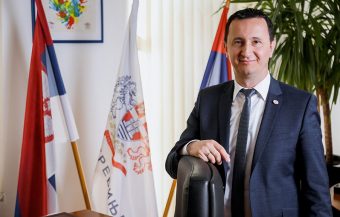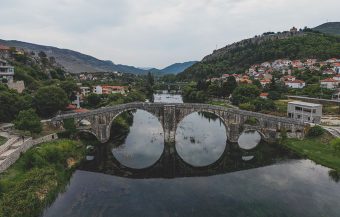
Trebinje is located at the foot of the Leotar Mountain, along the Trebješnica River, resting in the shade of hundred-year-old plane trees. This is a town of many happy returns with a coastline spirit. The oldest inscription of the town’s current name is carved on the gravestone of the prefect Grda, dating back to the second half of the 12th century. Today, this town proudly shows relics from all eras and rulers under which it developed. We spoke with Mayor Mirko Ćurić about the town’s plans and everything that makes Trebinje the way it is.
Q: You have clearly defined energy efficiency goals. How will you accomplish the set goals, and what has been done so far?
A: In 2010, the Trebinje authorities recognized the importance of the Covenant of Mayors Initiative in reducing carbon dioxide emissions by 2020. Back in 2011, we adopted SEAP (the Sustainable Energy Action Plan) for Trebinje. In the previous period, many projects and activities were implemented that have resulted in us accomplishing the set goals, such as implementing energy management. In 80 per cent of public lighting fixtures, we replaced inefficient mercury bulbs with efficient LED bulbs, and we have allocated funds in our 2024 budget to complete this process. In this phase of project implementation, electricity consumption was reduced by more than 280,000kWh, which caused a reduction of CO2 by about 1,000 tons. Regarding public buildings, energy efficiency has been improved in several of them, exterior doors and windows have been replaced, building fronts have been repaired, and roofs have been reconstructed. The same was done in kindergartens, elementary and high schools and other facilities. We are moving towards the reconstruction of all public buildings following our energy efficiency goals for these buildings. When issuing building permits, we ensure that new building developers observe energy efficiency measures and obtain an energy certificate.
IN FOCUSE:
- LOW-CARBON ECONOMY IS A LONG-TERM ENERGY POLICY PRIORITY
- RECYCLING PACKAGING AT LIDL: DONATE OR REDUCE THE BILL
- SUSTAINABLE WASTE MANAGEMENT WITH GREEN ENERGY

We plan and continuously invest in the reconstruction and rehabilitation of roads. In this way, energy loss is reduced. By building roundabouts in places where it is recommended to do so and in line with the traffic regulation project, we have also managed to reduce exhaust gas emissions. In 2023, the project Digitization of Stationary Traffic Management in the Town Centre was implemented, significantly reducing the time it takes for vehicles to reach free parking spaces and reducing the amount of exhaust gases. We are constantly working to boost awareness and hold training sessions as part of various projects the town’s authorities implement. Energy consumption is also regularly monitored while energy-saving measures are analyzed and implemented (EMIS). Regarding rainwater and sewage management, we have implemented a series of projects – the wastewater treatment plant was reconstructed, the existing sewage grid was extended, and many households were connected to it. Under the auspices of the NAP project, which UNDP implemented, Trebinje authorities drafted the following documents – ‘Climate Vulnerability Assessment and Strategy for Innovative Financing of Investments’ and ‘Adaptation to Climate Change in the Town of Trebinje’. A waste management plan was drafted and adopted, and a project for rehabilitating the existing and constructing a new sanitary landfill to dispose of household waste was also devised.
In the previous two years, we spent over 500,000 euros on the equipment and professional training of fire-rescue units, all aiming to take preventive and timely action and reduce the consequences of fires.

Q: You are a signatory to the Mayors’ Covenant, by which you undertook to reduce carbon dioxide emissions. How do you implement this, and what are your plans for the next period?
A: In the coming period, we plan to fully replace mercury lamps with LED lamps. Funds for this project are allocated in the 2024 budget. Also, we plan to spend significant financial resources on expanding the sewage grid over the next two years and connect about 400 more households to it. We have been continuously investing in acquiring additional equipment and providing training for voluntary and professional fire rescue units. We also plan to ban the use of coal by both public entities and individuals in Trebinje and the use of plastic bags.
Q: You are the host of the Energy Summit. How important is a gathering like this for Trebinje? How important is the transition to renewable energy sources for the town, and could you tell us more about the projects in this segment?
A: The Energy Summit is an important event for Trebinje, and every year, it gathers numerous eminent experts from the energy sector, not only from the region but also from all over Europe. Thanks to this event, Trebinje is positioned as an important place in the energy sector, considering that our town has two hydropower plants and is the headquarters of the Electric Power Company of the Republic of Srpska (ERS) and the Regulatory Energy Commission of the Republic of Srpska. Since this has become a traditional event and there is growing interest in other similar events covering different sectors, the Trebinje authorities and ERS agree that Trebinje should get a proper congress centre. ERS has already launched a competition for a conceptual architectural solution for the future centre. I hope that in 2024, we will have the main project of this future building, which will be built in the area included in the Novo Trebinje Zone Plan.
Once the centre is constructed, the Trebinje Energy Summit, similar events, and other large-scale conferences will finally occur in adequate facilities.
Interviewed by: Milica Radičević
Read the story in the new issue of the Energy portal Magazine RESPONSIBLE BUSINESS



